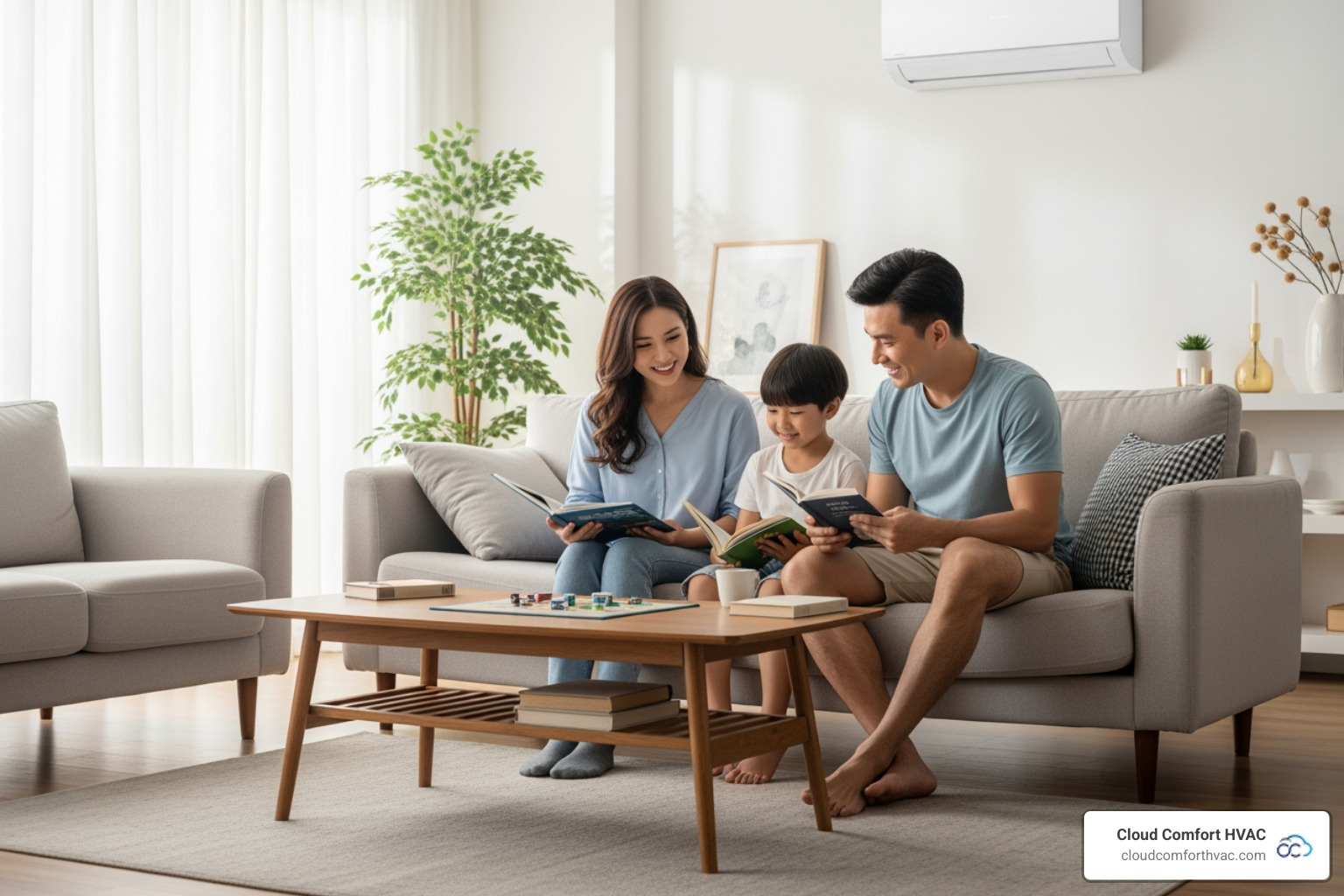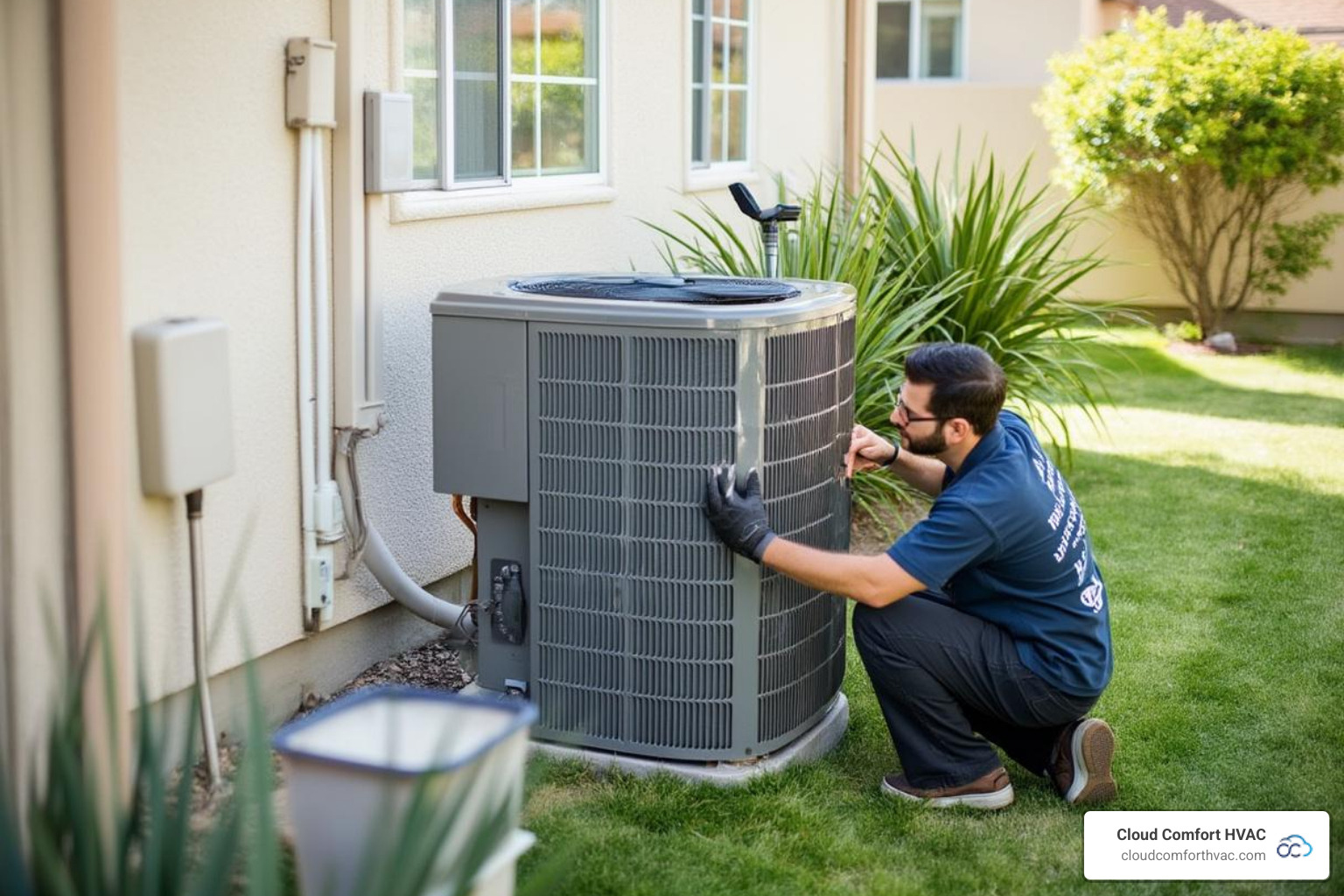Heat Your Home, Not the Planet: Sustainable Options
Why Your Heating System Matters for the Environment
Eco friendly heating systems can transform your home comfort while cutting energy bills by up to 50% compared to traditional systems. Here are the top sustainable heating options available today:
Most Efficient Eco-Friendly Heating Systems:
- Heat Pumps - Use 50% less energy than conventional systems
- Geothermal Systems - Reduce heating costs by up to 70%
- High-Efficiency Furnaces - AFUE ratings of 90-98%
- Solar Thermal Systems - Harness free energy from the sun
- Biomass Heating - Burns renewable organic materials
Your heating and cooling system accounts for 56% of your home's total energy use. That's more than half your energy bill going toward keeping comfortable.
The good news? Modern eco-friendly heating technologies don't just help the planet - they help your wallet too. Americans saved over $19 billion in 2008 alone by switching to green heating systems.
Whether you're dealing with sky-high energy bills, an aging furnace, or uncomfortable hot and cold spots, sustainable heating solutions offer reliable comfort with lower environmental impact. These systems transfer heat rather than generate it, making them incredibly efficient.
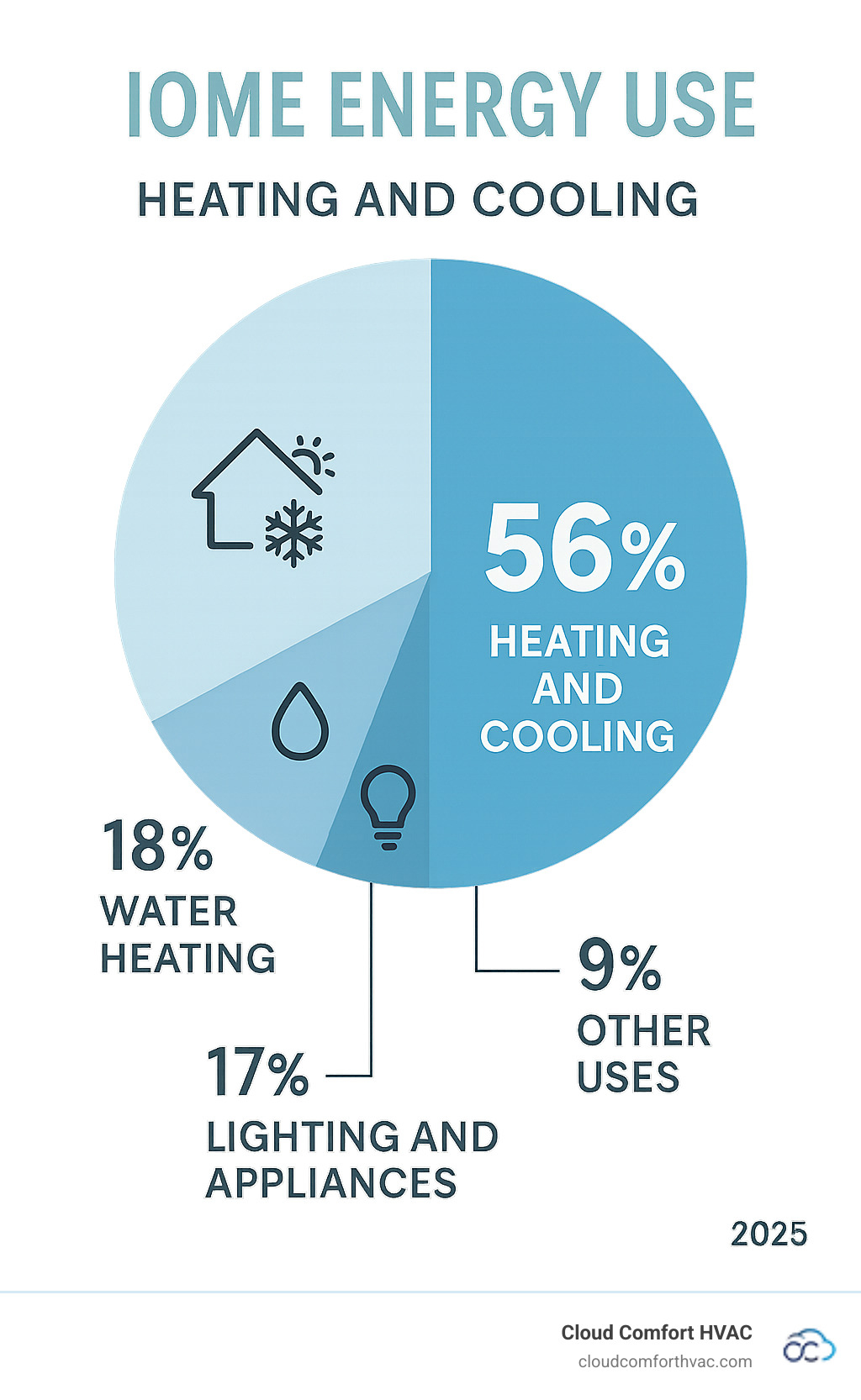
The Power of Heat Transfer: Air-Source & Geothermal Heat Pumps
Here's what makes eco friendly heating so brilliant: instead of burning fuel to create heat, these systems simply move heat from one place to another. Think of it like a magic trick where energy appears without the usual wasteful puff of smoke.
Heat pumps work by transferring existing heat rather than generating it from scratch. This clever approach makes them incredibly efficient - we're talking about systems that can slash your energy use by up to 50% compared to traditional furnaces and air conditioners.
What's even better? You get dual heating and cooling function from a single unit. No need for separate systems cluttering up your home. One sleek system handles your comfort year-round, delivering those sweet long-term savings while shrinking your carbon footprint.
High-efficiency models are the real game-changers here. They're like the overachievers of the HVAC world, constantly working to keep your bills low and your home perfectly comfortable.
Air-Source Heat Pumps: The Versatile All-in-One
Air-source heat pumps are the Swiss Army knives of home comfort. These clever machines work through something called the refrigerant cycle - basically the same process your refrigerator uses, but working in reverse and with the ability to switch directions.
Here's how the magic happens: Even when it's freezing outside, there's still heat energy in that cold air. The outdoor unit captures this heat using a special refrigerant that absorbs it and turns into gas. A compressor then squeezes this gas, making it super hot. This hot gas travels indoors where it releases all that heat into your home, then cools back down to liquid and heads outside to start the cycle again.
When summer rolls around, the system simply flips the script. It pulls heat from inside your house and dumps it outside, leaving you with cool, comfortable air.
SEER and HSPF ratings tell you just how efficient your heat pump will be. SEER measures cooling efficiency, while HSPF measures heating performance. Higher numbers mean lower bills - it's that simple.

Modern heat pumps have come a long way with cold climate performance. Today's models can efficiently heat your home even when temperatures drop well below freezing. That's great news for those chilly winter nights.
Beyond just moving heat around efficiently, these systems offer some pretty sweet perks. Year-round comfort from one unit means less equipment to maintain. They run quieter than traditional systems, so you won't hear them chugging away. Many models also filter your air, removing dust and allergens for better indoor air quality.
For homeowners in areas like Manhattan Beach and Torrance, air-source heat pumps are perfect for our mild climate variations. They provide consistent comfort without the energy waste of older systems.
Want to dive deeper? Check out the Advantages of Heat Pumps for Energy Efficiency and learn more about Heating and Cooling With a Heat Pump.
Geothermal Systems: Tapping into Earth's Energy
If air-source heat pumps are impressive, ground-source heat pumps are absolutely mind-blowing. These systems tap into something most people never think about - the stable underground temperatures just a few feet beneath your yard.
Here's the cool part: while the weather above ground swings from scorching summers to freezing winters, the temperature underground stays remarkably consistent. We're talking about a steady 42 to 80 degrees year-round, depending on your location. It's like having a natural climate control system buried right under your feet.
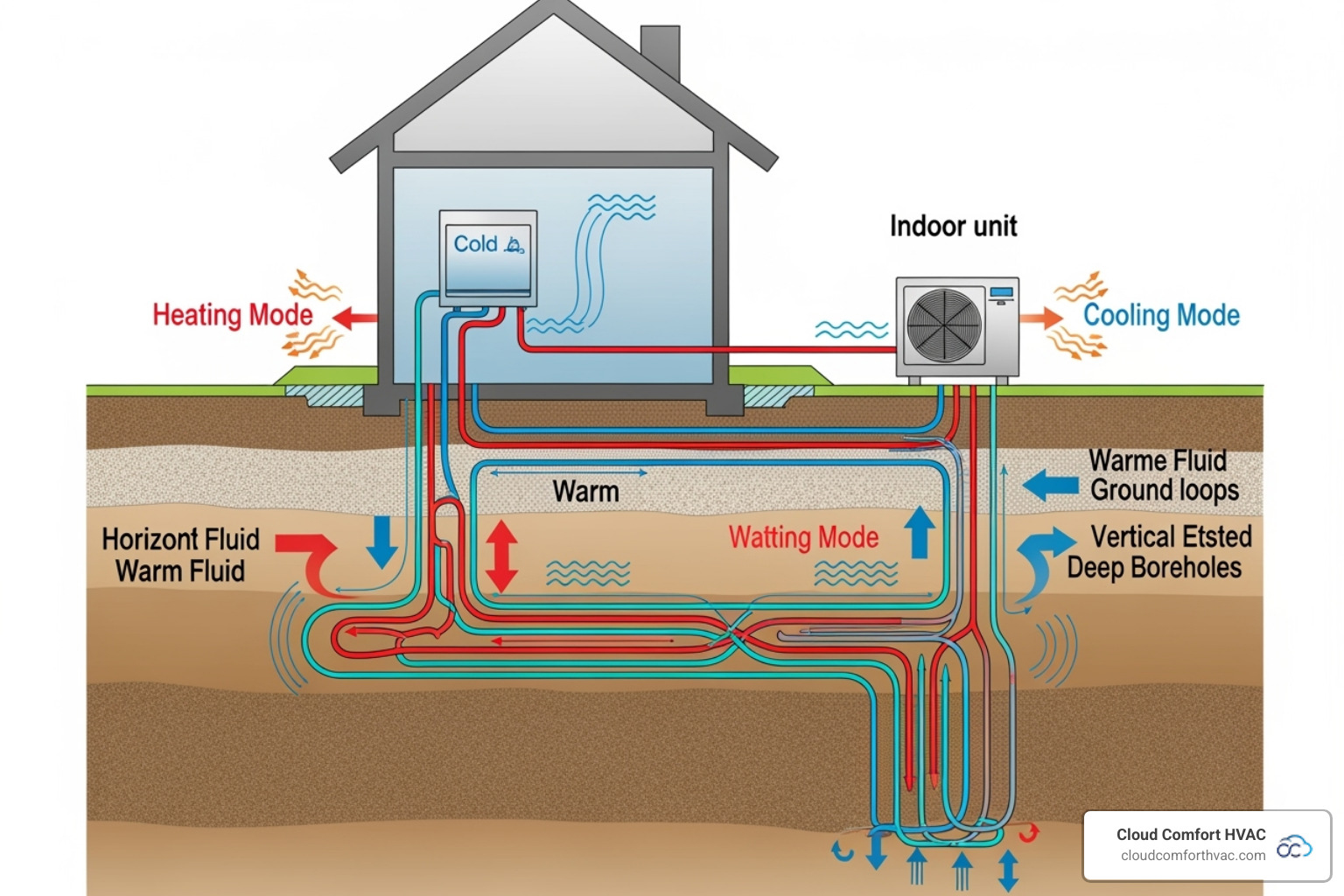
Geothermal loops are the secret sauce here. These underground pipes circulate a water-based solution that absorbs heat from the earth in winter and deposits heat into the cooler ground during summer. Think of it as having a direct line to the planet's own energy source.
The highest efficiency numbers belong to geothermal systems. They can cut your heating and cooling costs by up to 70% compared to conventional systems. That's not a typo - seventy percent!
Durability is another huge win. While most HVAC systems last 15-20 years, geothermal systems can keep running strong for 25 years or more. The underground loops? They can last over 50 years. Talk about a long-term investment that pays off.
Because geothermal systems use the earth's natural thermal energy, they produce incredibly low greenhouse gas emissions. You get consistent performance regardless of outside weather conditions, and they operate almost silently since most components are underground.
The upfront investment is higher than other systems, but the long-term savings make geothermal incredibly cost-effective over its lifetime. When you're weighing your options, it helps to compare all the benefits. Our guide on Heat Pump vs Furnace: Which Heating Solution is Best for Your Home can help you understand how these systems stack up against traditional heating methods.
Exploring Other Eco-Friendly Heating Technologies
Heat pumps might steal the spotlight in eco friendly heating, but they're not the only sustainable stars on stage. A whole cast of renewable energy technologies is waiting in the wings, each offering unique ways to keep your home cozy while treating our planet kindly.
These alternative systems share a common goal: reducing our reliance on fossil fuels while delivering reliable comfort. Whether you're looking to complement your existing system or explore completely different approaches, these technologies prove that going green doesn't mean sacrificing warmth.
Solar Thermal Heating
Most people think solar panels when they hear "solar energy," but solar thermal heating takes a more direct approach. Instead of converting sunlight to electricity, these systems capture the sun's heat and put it straight to work warming your home.
Passive solar design is like giving your house a natural heating instinct. Strategic window placement lets winter sun pour in and warm up thermal mass materials like concrete floors or stone walls. These materials act like giant heat batteries, soaking up warmth during the day and releasing it slowly as temperatures drop. Proper overhangs keep summer sun from turning your home into an oven.
Active solar systems are more hands-on helpers. Solar collectors on your roof grab sunlight and transfer that heat to water or antifreeze solution flowing through pipes. This heated liquid then warms your home's air or water supply through a heat exchanger.
The beauty of solar thermal systems lies in their efficiency. While solar panels convert about 10% of sunlight into electricity, solar thermal systems can capture much more of that energy as usable heat. They're particularly brilliant for water heating integration, often reducing gas consumption by up to 70%.
Other Sustainable Options: Biomass and Hydronic Heating
Biomass heating brings us back to our roots - literally. These systems burn renewable organic materials like wood pellets, chips, or agricultural waste. When sourced responsibly, biomass fuel is considered carbon-neutral because the CO2 released during burning equals what the plants absorbed while growing.
Modern biomass systems are light-years ahead of grandpa's old wood stove. They burn cleaner, more efficiently, and with far fewer emissions. For rural homeowners especially, biomass can be a readily available and cost-effective alternative to fossil fuels.
Hydronic heating might remind you of those old-fashioned radiators, but today's systems are sleek efficiency champions. These systems circulate hot water through pipes embedded in floors, walls, or connected to modern radiators. Heat transfers through conduction and radiation rather than blowing air around.
The benefits make hydronic systems shine. Water holds heat incredibly well, and without ductwork to leak energy through, efficiency stays high. Radiant floor heating provides wonderfully even warmth rising from the ground up, eliminating cold spots entirely.
Here's where hydronic systems really excel: allergen reduction. Since there's no forced air circulation, dust, pollen, and other particles stay put instead of swirling around your home. People with allergies or respiratory sensitivities often find dramatic relief.
The quiet operation is another bonus - no noisy fans or blowers, just whisper-quiet comfort. Hydronic systems also play well with others, pairing beautifully with high-efficiency boilers, geothermal heat pumps, or solar thermal systems.
While traditional systems have their place (you can explore The 5 Benefits of Gas Furnaces for comparison), these sustainable alternatives offer exciting pathways to eco friendly heating that many homeowners are finding work wonderfully for their unique situations.
How to Make Your Current System More Sustainable
Not ready to replace your entire heating system just yet? That's perfectly okay! You don't need a complete overhaul to start making a real difference. There are plenty of smart, low-cost upgrades and simple changes that can transform your existing HVAC system into a more eco friendly heating solution. These improvements can deliver immediate energy savings while you plan for bigger changes down the road.
Think of it like giving your heating system a green makeover. Every small step counts, and the best part? Many of these changes will start saving you money right away while reducing your environmental footprint.
Simple Steps for a Greener HVAC
Your journey toward more sustainable heating starts with understanding that your current system probably has untapped potential. With a few smart moves, you can dramatically improve its efficiency and environmental impact.
Regular maintenance is your secret weapon. Just like your car runs better with regular tune-ups, your HVAC system needs professional attention at least once a year. A well-maintained system can use up to 15% less energy than a neglected one. We recommend scheduling service before peak heating season to catch small problems before they become energy-wasting disasters.
Filter changes might seem basic, but they're game-changers. A dirty filter is like trying to breathe through a straw - your system has to work much harder to push air through. Check your filter monthly and replace it every one to three months. If you have pets or family members with allergies, you might need to change it more frequently.
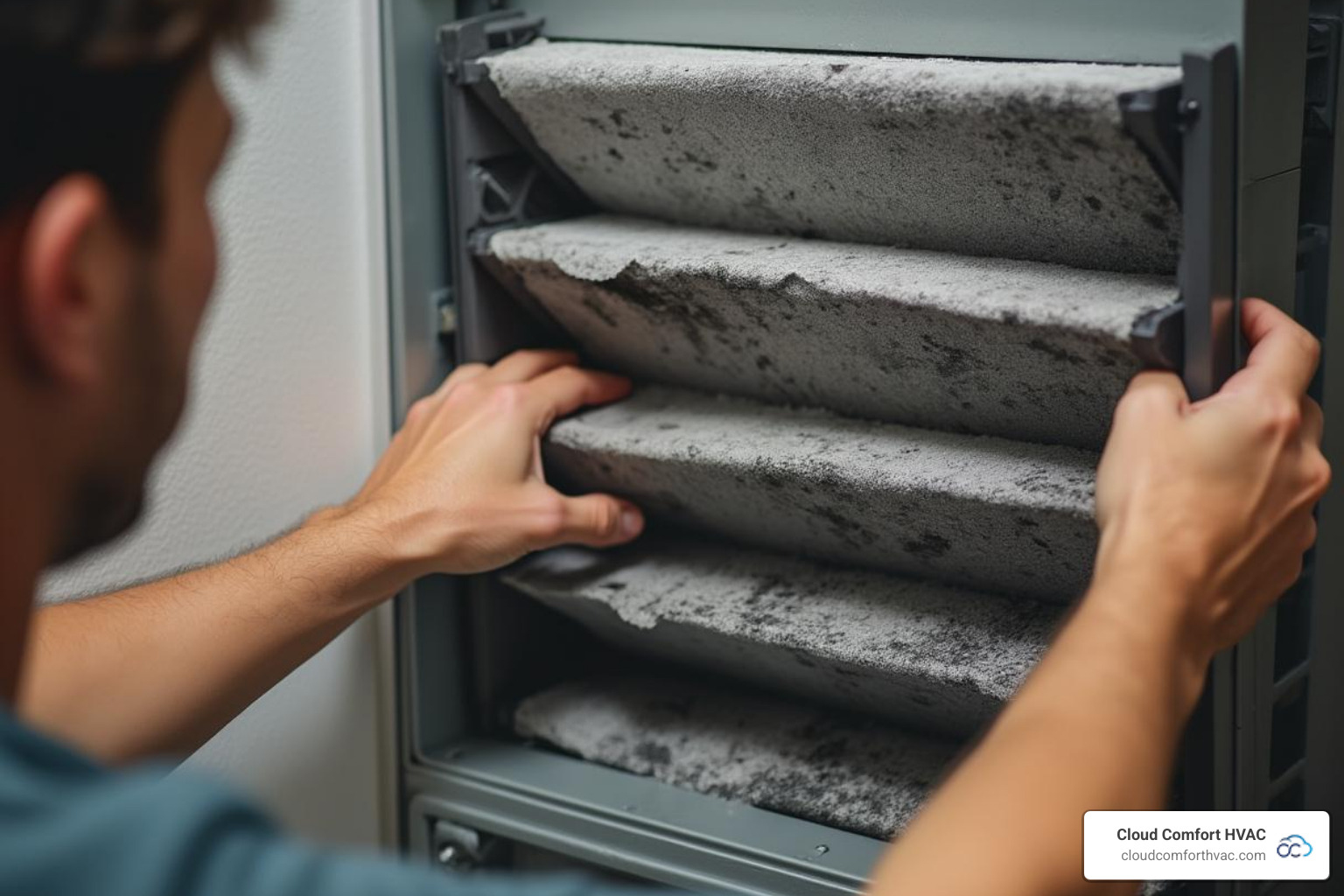
Smart and programmable thermostats are where technology meets savings. These clever devices learn your schedule and adjust temperatures automatically. Why heat an empty house to 72 degrees when you're at work? Smart thermostats can reduce your heating costs by 10-15% just by being, well, smart about when to heat and cool your home.
Ductwork sealing is the hidden opportunity most homeowners miss. Leaky ducts can waste up to 30% of your heated air before it even reaches your living spaces. That's like throwing money out the window! Sealing and insulating your ducts ensures that warm air actually makes it to where you need it most.
Home insulation improvements work hand-in-hand with any heating system. Think of insulation as a cozy blanket for your entire house. Better insulation in your attic, walls, and floors means your heating system doesn't have to work as hard to keep you comfortable. Don't forget those sneaky air leaks around windows and doors - weatherstripping and caulk are inexpensive fixes that pack a big punch.
Keep those vents clear and unobstructed. It sounds simple, but furniture, curtains, and decorations blocking vents force your system to work overtime. Make sure air can flow freely throughout your home for maximum efficiency.
These steps transform your existing system into a more sustainable heating solution without breaking the bank. You're not just saving energy - you're actively reducing your carbon footprint while keeping your family comfortable.
Understanding Efficiency for eco friendly heating
When it comes to making your current system more sustainable, understanding efficiency ratings is like having a roadmap to savings. These numbers tell the real story about how much energy you're actually getting for your money.
AFUE ratings are the key to understanding furnace efficiency. Annual Fuel Utilization Efficiency measures how much of your fuel actually heats your home versus how much gets wasted. It's expressed as a percentage, and the difference between old and new systems is eye-opening.
Older furnaces are energy hogs. Systems installed before the 1990s typically have AFUE ratings under 70%. This means that for every dollar you spend on fuel, 30 cents or more literally goes up the chimney. That's like filling up your gas tank and having someone siphon out a third of it before you drive anywhere.
Modern high-efficiency furnaces are completely different animals. Today's best systems achieve AFUE ratings of 90-98%, meaning virtually all your fuel money goes toward actually heating your home. The technology behind this efficiency includes sealed combustion systems and secondary heat exchangers that capture heat that older systems simply waste.
Energy Star certification takes the guesswork out of efficiency. This government-backed program identifies the most efficient systems available, making it easy to spot the real energy savers. Energy Star certified furnaces use significantly less fuel than standard models, reducing both your bills and your environmental impact.
The jump from an old, inefficient furnace to a modern, high-efficiency model represents one of the biggest opportunities for eco friendly heating improvements. While the upfront investment is significant, the long-term savings in fuel costs and the reduction in greenhouse gas emissions make it a smart choice for both your wallet and the planet.
For detailed insights into how much you could save and the environmental benefits of upgrading, explore our comprehensive guide on the Benefits of Upgrading to an Energy Efficient Furnace. The numbers might surprise you - and motivate you to make the switch sooner than you planned.
Choosing Your Ideal Green Heating System
Finding the perfect eco friendly heating system for your home feels a bit like finding the right pair of shoes – it needs to fit just right, match your lifestyle, and work well with what you already have. What keeps your neighbor cozy in Manhattan Beach might not be the best choice for your home in Torrance, and that's perfectly normal.
The exciting part? You have more options than ever before, and many come with financial incentives that make the decision even sweeter. Let's walk through what matters most when choosing your ideal green heating solution.
Key Factors for Your Home and Climate
Think of choosing an eco friendly heating system like planning the perfect outfit for your local weather. Just as you wouldn't wear the same jacket in sunny Manhattan Beach as you would in chilly mountain areas, your heating system needs to match your specific environment and home.
Your local climate plays a huge role in system performance. While modern air-source heat pumps work beautifully in our coastal Southern California weather, they perform differently in areas with harsh winters. Geothermal systems, on the other hand, don't care what's happening above ground – they tap into the Earth's steady underground temperature year-round.
Home size and layout matter just as much as climate. A cozy beach cottage might thrive with a ductless mini-split system, while a sprawling two-story home typically needs something more robust like a central heat pump or geothermal system. It's about matching the system's capacity to your space.
Here's something many homeowners overlook: your home's insulation levels can make or break any heating system's performance. Even the most efficient heat pump will struggle in a poorly insulated home. Think of insulation as a warm coat for your house – without it, you're essentially trying to heat the great outdoors.
Budget considerations go beyond the initial price tag. Yes, systems like geothermal or high-efficiency heat pumps cost more upfront than traditional furnaces. But here's the thing – they often pay for themselves through energy savings over time. We help our customers understand the complete financial picture, not just the installation cost.
Available fuel sources in your area also influence your best options. Do you have access to natural gas? Is your local electricity grid becoming greener with renewable energy? These factors affect both cost and environmental impact.
The most critical factor? Professional installation and sizing. Even the most advanced system won't deliver promised efficiency if it's incorrectly sized or poorly installed. At Cloud Comfort HVAC, we take pride in getting this right the first time, ensuring your new system performs exactly as intended.
Financial Incentives for eco friendly heating
Here's where choosing eco friendly heating gets really exciting – you're often not paying the full price. Government agencies and utility companies are practically rolling out the red carpet for homeowners who choose sustainable heating solutions.
Federal tax credits can significantly reduce your tax bill when you install qualifying systems like heat pumps, geothermal units, or solar thermal systems. These aren't deductions – they're direct reductions in what you owe the IRS. You can explore current federal opportunities at Find federal incentives for renewables & efficiency.
State and local rebates vary by location, but they're often substantial. California, for instance, frequently offers generous rebates for energy-efficient upgrades. Whether you're in Rancho Palos Verdes, Carson, or Culver City, there are likely programs available in your area.
Don't forget about utility company programs. Your local utility often provides incentives because efficient homes reduce strain on the power grid. These might include cash rebates, low-interest financing, or even free energy audits to help you identify the best upgrades.
The beautiful thing about these incentives is how they work together. You might qualify for a federal tax credit, a state rebate, and a utility incentive on the same system installation. This can dramatically reduce your effective installation cost, making your long-term energy savings even more attractive.
Our team stays current on available programs and helps ensure your chosen system qualifies for maximum incentives. We believe everyone should have access to efficient, sustainable home comfort, and these programs help make that possible.
Conclusion: A Comfortable and Sustainable Home Awaits
Your journey through eco friendly heating has revealed exciting possibilities for your home. From the remarkable efficiency of heat pumps that can slash your energy bills in half, to geothermal systems that tap into the Earth's constant temperature, to solar thermal solutions that harness free energy from the sun - the options for sustainable comfort are more accessible than ever.
The beauty of these technologies lies in their dual promise: environmental responsibility paired with genuine financial savings. When you choose an eco-friendly heating system, you're not making a sacrifice - you're making a smart investment. The reduced utility bills, available government rebates and tax credits, plus the increased value these systems add to your home make them financially attractive from day one.
But beyond the numbers, there's something deeply satisfying about knowing your home comfort doesn't come at the planet's expense. Whether it's a heat pump quietly transferring energy outside your Manhattan Beach home or a geothermal system silently drawing from the earth beneath your Palos Verdes property, you'll enjoy consistent warmth and cooling while reducing your carbon footprint.
At Cloud Comfort HVAC, we've seen how these systems transform homes across Rancho Palos Verdes, Culver City, Torrance, Palos Verdes Estates, and Carson. Our passion for eco friendly heating solutions stems from years of witnessing families find that green technology delivers superior comfort, not compromise.
Expert installation makes all the difference with these advanced systems. Our team ensures your new heat pump, geothermal system, or high-efficiency furnace performs exactly as promised. With our transparent pricing, strong Daikin warranties, and 1-year Comfort Promise, you can invest in your home's future with complete confidence.
Maybe you're ready to make the leap to a completely new system, or perhaps your current furnace just needs some professional attention to run more efficiently. Either way, we're here to help you create the comfortable, sustainable home you deserve.
Your wallet and the environment are both waiting for you to take the next step. Schedule your furnace repair in Torrance, CA or reach out to explore how eco friendly heating can transform your home comfort experience. The future of home heating is here - and it's greener, more efficient, and more comfortable than ever before.

.avif)
Customer Testimonials
Hundreds of 5-Star Reviews on Google Show Our Commitment to Customer Satisfaction




New Air Conditoining Unit for as low as $79/mo + Free Wi-Fi Thermostat
(Or As Low As $4,995 as a One-Time Payment)
FINANCE WITH $0 PAYMENTS & 0% INTEREST FOR 12 MONTHS, OAC
Hurry! Offer Ends Soon.



